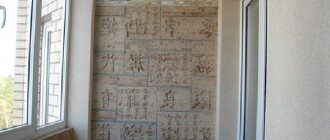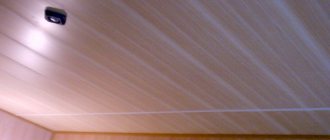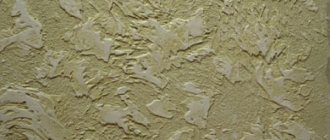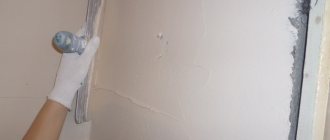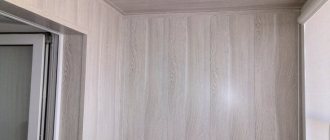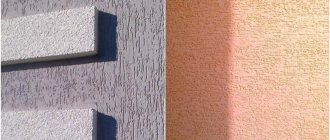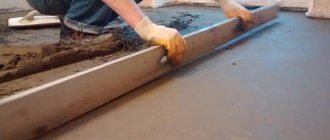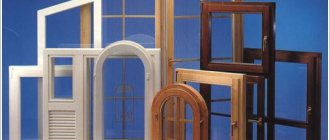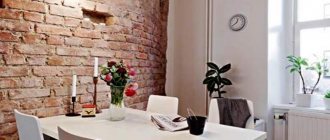Uneven ceilings with crumbling whitewash and cracked plaster are a thing of the past. Today's ceiling repair options allow you to get a fairly smooth coating with any result.
Attention! The most difficult thing is to choose the best option from a variety of methods and settle on one of dozens of finishing materials.
When choosing, you should take into account almost everything: room humidity, room height, interior design style, as well as the renovation budget.
Wallpapering
There are different options for decorating the ceiling with your own hands, but wallpaper has not lost its popularity even today. In fact, any type of this material is inexpensive, and preparing glue and gluing canvases can be done by an inexperienced craftsman.
When you work with wallpaper, you need to consider the following facts:
- Their advantage is a wide range in comparison with whites and paints. You can choose wallpaper with the desired color and structure. In addition, photo wallpaper will help you apply a variety of images and paintings to the ceiling.
- In order to quickly change the design of a room, you can buy wallpaper that is not afraid of paint. This will create a real canvas on the ceiling where you can depict virtually anything. These types of ceilings in apartments are very popular today.
- You should not use paper wallpaper, because there are many problems with it even when covering walls. The ceiling always complicates the process itself significantly. The best option for wallpapering the ceiling is non-woven material, which is much denser than paper and is not afraid of moisture.
- If you want to use some unusual variations in the design of the ceiling in your apartment, you should think about liquid wallpaper for the ceiling. The latter are applied to a pre-dried surface with a special gun. Then they are smoothed out, creating a special relief. On the other hand, the patterns will be of the same type, and dirt is the eternal companion of this option.
Paper wallpaper
This material is used very rarely. A ceiling decorated with paper wallpaper will not last long, but it will take a lot of time and effort to arrange it.
Attention! Currently, this wallpaper is used to decorate children's rooms and other rooms where frequent cosmetic repairs are necessary.
Paper wallpaper hides significant defects in the ceiling, is cheap and does not “steal” excess space.
Disadvantages:
- Short service life.
- The need for careful preparation of the ceiling surface.
Liquid options
Liquid wallpaper hardens very quickly, is easy to apply, and does not fade when exposed to the sun. In addition, they are highly wear-resistant. In addition, it is possible to replace any damaged area without completely removing the entire coating. This makes them very popular.
It should be remembered that all these properties relate only to materials that are manufactured using precise technology. Various handicraft wallpapers may not have them. The key disadvantage is the high price. Also, this coating is very poorly resistant to moisture.
Textile
How can you currently decorate the ceiling so that it is completely different from everyone else? For all lovers of the original, there are the following options for finishing the ceiling: covering with chintz, silk, linen, tapestry and special furniture fabrics. In addition, even burlap is suitable for finishing the ceiling.
These ceiling design options will appeal to all creative people who will choose their own combinations, patterns, colors, and so on. And if you involve professionals in the matter, the price of the project can turn out to be quite high. The key advantage is the exclusive appearance.
Flaws:
- Short service life.
- The fragility of this coating.
Types of decorative plaster
The main components of the material are sand and cement; fillers provide all the qualities and properties. Elements change the structure, add volume and texture.
Conventionally, products are divided into 2 types:
- Structural. Initially it has a white color, the use of pigments is allowed. The simple composition allows you to use the mixture on any surface, giving it an original shape. The mass is grainy and highly plastic.
- Textured. The granular structure varies according to the size of the granules:
- large 3-5 mm;
- average 1.5-2.5 mm;
- small 0.5-1.0 mm;
- thin up to 0.5 mm.
Despite the graininess, the mass is homogeneous. After application, the surface becomes smooth with visible patterns and texture.
Advice! When selecting a material, it is important to pay attention to the composition (printed on the packaging). Antiseptics, thickeners, preservatives are elements that give the product strength and water resistance.
Further, the plaster differs in composition:
- Polymer. The base is acrylic resin. The material has the properties to withstand humidity and temperature changes.
- Silicone. The base is silicone resins. The products allow steam to pass through, resist water, are not subject to temperature fluctuations, and also have many color options.
- Silicate. Base: liquid potassium glass, alkaline components. The mixture is flexible and resists fungus, humidity, and temperature fluctuations. Silicate plaster resists dirt.
- Mineral. The base is lime, so the mixture is considered environmentally friendly. The plaster gains strength along with the length of time it is used. It has no dyes and can acquire a noble yellowness and shine over the period of use.
Also, types of decorative plaster for ceilings differ in the type of additives:
- acrylic resins – water resistance;
- polyurethane, epoxy resin extend service life;
- granite, quartz (fine fillers) increase the wear resistance of the coating.
When using granite or quartz chips, the surface is roughened, but it all depends on the size of the fraction. But you need to be careful with polyurethane and epoxy fillers - at high temperatures the materials emit harmful fumes.
Advice! The popular plaster with marble chips is not wear-resistant, despite all the assurances of the manufacturers. Suitable for rooms with normal humidity levels. But if you need rough, rough decorative plaster on the ceiling, a mixture with quartz or granite chips is preferable.
The larger the grain, the smoother the ceiling surface will be, but painting the ceilings will be more difficult. And fine-grained mixtures will not hide the unevenness of the ceiling surface. This should also be taken into account when choosing plaster.
Stretch ceiling
Stretch ceilings are a structure whose main element is the canvas. The latter is mounted directly under the ceiling on plastic or metal profiles. Options for stretch ceilings: films made from PVC (matte canvas, glossy or satin ceilings), as well as fabric canvases.
Which fabric and texture is better? Which manufacturer should you prefer? Find out which stretch ceilings are better!
Characteristics of modern stretch ceilings:
- Excellent hydro- and thermal insulation. With this ceiling, a flood suddenly caused by neighbors above is no longer a problem at all, since the coating will retain water, which can then be drained.
- They don't take up too much space. Therefore, the height of the room will not be affected.
- You can choose shapes and colors to suit every taste.
- They are afraid of any sharp objects.
- High price.
Materials for repair and finishing
The ceiling surface can be finished in several ways:
- to be painted;
- to paste over;
- tension systems;
- hanging structures.
Advice When choosing the type of finishing, it is necessary to take into account the characteristics of the room, its dimensions, ceiling heights, natural lighting, and other parameters.
Popular materials by group:
- Painting with water-based paints, acrylic, latex, oil or traditional whitewash.
- Pasting with liquid wallpaper, vinyl roll materials, special fabric, polyvinyl chloride plates for frameless installation, wooden wallpaper.
- Stretch seamless fabric or film structures with a visible seam.
- Wall-mounted structures covered with plasterboard sheets, plastic or metal panels, MDF cladding, lining with single-level or multi-level organization (how to make a two-level ceiling with your own hands?).
- Rack systems made of aluminum, wood, plastic sheets with open, semi-open or closed type of fastening.
- When painting, surface preparation is required, which consists of leveling the ceiling with cement or gypsum-containing mortar and then covering it with a finishing layer of putty. It is necessary to apply a deep penetration primer.
- Similar actions may be required before pasting with rolled materials or fabrics that hide only small cracks or defects no deeper (wider) than 2–3 mm. The canvases are attached with special glue.
- Suspended, slatted structures require the construction of a frame consisting of:
- guides and ceiling profiles;
- suspensions with fixed and adjustable heights;
- fastening elements (self-tapping screws, screws with press washers, dowels);
- ceiling plinth or molding.
fastenings for planks;
Additionally, spot or decorative lighting can be installed, therefore, in addition to the devices themselves, it is necessary to install fasteners for them, clamps for electrical wiring, which should be located no closer than 5 cm to the elements of the metal frame.
Whitewash
The very name of this type of finish already says a lot. Whitewashing is the decoration of ceilings with a lime or chalk composition, which gives the ceiling a snow-white texture (provided the base is properly prepared).
The key words here are “prepared base”: before starting such ceiling finishing, it is necessary to do a number of labor-intensive and troublesome works (plastering, leveling), the quality of which will certainly affect the final appearance of the coating.
Advantages:
- Low price of materials.
- Technological simplicity of all work.
Flaws:
- Labor intensity.
- The need for good protection during whitewashing the walls of furniture, as well as one’s own person.
- Fragility (service life - no more than two years).
- Quick loss of the beautiful appearance of ceiling finishing in direct contact with water (if the neighbors above cause a flood in their own apartment, then you will have to refinish the ceilings).
Painting
This method of decorating ceilings is very familiar to the eye. The painted ceiling looks attractive, and the cost of finishing it is low. In addition, you can paint the ceiling in a variety of colors, guided only by its harmonious participation in the interior of the room, as well as your own tastes.
Advantages:
- Low price of materials.
- Practicality of the coating in everyday life.
Flaws:
- The dependence of the decorative effect of the coating on the professionalism of the finisher.
- Tendency to cracks.
- Fragility (service life - no more than two years).
- Labor intensity of preparatory work.
Dropped ceilings
This ceiling design option has gained popularity due to its simple installation system. During installation, fastening profiles must be used, which are fixed to the ceiling surface and walls. Therefore, no preliminary leveling is required, and the work proceeds quite cleanly.
Plasterboard
Finishing with plasterboard is the most popular type of ceiling design in an apartment. Using gypsum board slabs you can make not only an ordinary ceiling, but also an amazing multi-level structure or niche. The plasticity of this material allows you to create the strangest and most bizarre shapes for different interiors.
Among the advantages, it is necessary to note the ease of installation - even an inexperienced person can sheathe the ceiling with plasterboard. In addition, the material is inexpensive.
The main disadvantage is the “fear” of water. When exposed to moisture, such a ceiling quickly collapses. Before covering the ceiling with plasterboard, it is necessary to consider the thermal insulation layer and lighting system. Another drawback is the need for subsequent finishing of the coating with putty and paints.
Tiled
This method of finishing the ceiling is one of the most affordable and budget-friendly. That is why it is often used in hospitals, office spaces and other buildings where practicality is a priority and an attractive appearance is not necessary.
The installation of the material is carried out as follows: a special frame made of mesh is fixed on the main covering, where sheets of mineral fiber of various shapes are fixed.
The main advantage of this type of ceiling design in an apartment is the ability to disguise all utility lines under the slabs. In addition, the product is very easy to replace if damaged. Tiles today are produced in a wide range. Therefore, finding the right texture and color is very simple.
Disadvantages:
- Not the most beautiful appearance.
- Fragility of the material.
- The tiled construction reduces the height of the walls.
Cassette
This type of ceiling design is similar to the previous one. True, instead of fragile mineral sheets, durable cassettes made of plastic or metal are used here. The advantage is that there is insulation between the metal sheets. Due to this, the entire installation does not last long. The disadvantage is the price.
Rack and pinion
If a difficult dilemma arises about what to make ceilings from in the kitchen or bathroom, it is advisable to pay attention to this option. In this case, it is no longer tiles that are installed on the frame, but special long slats made of wood, plastic or galvanized aluminum. The result is a beautiful imitation of lining, although this finish costs much less.
Attention! Another advantage is the quick installation and easy repair of the material. Among the disadvantages is the rather short period of use of the coating - usually five years.
Combined
Currently, when creating a project for a home, designers often use several design options and two-level ceilings. Stretch and suspended ceilings are often combined. Sometimes a mirror is installed in a niche of a plasterboard structure, or a suspended ceiling is used as a border, and the main surface is leveled with plaster and then painted.
Glued ceilings
Here we are talking about a ceiling that is covered with tiles with one adhesive side. These products are very easy to install and have good moisture resistance. In this regard, they have gained popularity among Russian users. In addition, with the help of adhesive tiles you can save a lot on expensive stucco molding.
The main disadvantage of this ceiling design option is the need for careful leveling of the coating. In addition, such tiles are very fragile.
Where and how best to finish the ceiling
Different rooms, depending on their purpose, require different ceiling finishes. More precisely, each type of finish may be suitable for a specific room, or maybe not. Let's take a closer look at all the finishing options and determine where and which one is best to use.
On our market there is a huge selection of materials specifically designed for finishing ceilings. They allow you to choose the right colors and textures for all types of rooms. In addition, a rich assortment makes it possible to select materials that are perfect for working in certain conditions. And you should be especially careful with this if, a few months after the repair, you do not want to deal with it again.
In living rooms, hallways and living rooms, you can use almost any material to decorate the ceiling. With the right selection of materials and high skill in performing the work, you can get a truly magnificent spectacle. Well, other rooms, as a rule, require a completely different approach. Therefore, in the bathroom it is better to use PVC tiles, panels, slats or paint - it is beautiful, reliable, durable and not afraid of moisture. Well, in the kitchen you can use plastic or again paint. Stretch ceilings are universal and fit everywhere, but in the bathroom there is a high probability of piercing it if it is located low.
Finishing the ceiling in the kitchen
The choice of material for finishing the ceiling in the kitchen needs to be taken more seriously than for other rooms.
Which is not surprising, because in no other room do finishing materials have to face such loads (well, perhaps even in the → bathroom). Daily cooking places special demands on materials and work, as they cause constant changes in temperature and humidity, and in addition, they impregnate soft materials with corresponding odors, and not always only pleasant ones. In addition, ceilings are often covered with layers of grease and soot, which in no way gives them an aesthetic appearance. If you want to save as much as possible, you can use simple water-based paints. They, unlike lime, are easy to clean and dirt can often be removed in a matter of minutes using a regular damp cloth. However, there are many better ways to decorate ceilings without spending too much money.
Of course, this can be done using plastic panels. And PVC can really be an ideal option. After all, PVC panels are beautiful, easy to install, allow you to choose exactly the colors you need, and simply stand up well to numerous washes and cleanings. Of course, if you use plastic panels, you don’t have to worry about them absorbing grease or unpleasant odors. After all, such weaknesses have never been noticed in plastic. Stretch ceilings are also suitable (they are suitable everywhere).
Bathroom ceiling
Bathroom ceilings must be moisture resistant. Any moisture-resistant material is suitable. A suspended structure is desirable in order to install beautiful lamps in it, install electricity, and provide ventilation.
In other rooms, the ceiling decoration is not limited in any way, except on the balcony.
Good luck choosing materials and working! Leave your tips and comments below. Subscribe to our newsletter. Good luck to you and good luck to your family!
Ceilings made of natural materials
Recently, natural ceiling finishing options have become increasingly popular. Every year, more and more new methods of impregnation and processing of products are invented, increasing their performance characteristics.
Wooden lining
Wooden lining - thin wooden boards or MDF boards. The latter are attached to the frame using self-tapping screws, clamps or nails.
The main advantages of these materials:
- Attractive appearance.
- Environmentally friendly.
- Durability and strength.
Flaws:
- Limited color range.
- The need to use wood impregnations.
Timber ceiling
This type of ceiling is more suitable for a country house or cottage. It will look somewhat out of place in an apartment. However, some lovers of natural materials find use for it here too. The timber has all the characteristics of lining, but lasts much longer and is particularly durable.
Flaws:
- Quite a complicated installation.
- The need for ventilation.
- Before finishing the ceiling with such material, it will have to be impregnated for a long time with special compounds.
Cork covering
Cork ceilings, alas, are not widely used. However, this material has certain advantages: the presence of a wax coating reliably protects the surface from the deposition of dust and water, and also increases its service life.
Disadvantages:
- Difficult installation.
- High price.
Features of finishing ceilings in cottages
Because Since most cottages have wooden floors, it is more difficult to plaster them without a special mesh.
However, these days, ceilings are not plastered, but decorated with tinted beams and wooden paneling treated with paint and varnish. It is already possible to install a suspended or suspended ceiling into this foundation.
Plastic lining
When finishing the ceiling on the balcony, it is advisable to pay attention to PVC lining. The resulting coating will be durable and strong enough; a thermal insulation layer and utility lines can be hidden under it.
In addition, the material is available in a wide range, it is resistant to the development of fungi, mold and bacteria, as well as ultraviolet radiation. At the same time, this ceiling is very fragile and can be easily damaged by light mechanical impact. There will definitely be a special smell in the room for a couple of days after installation.
Multi-level structures
This ceiling can be decorated using any of the finishing materials listed above. However, it differs in its installation technology. In this case, we are talking about a variety of suspended structures that will be installed at different distances from the ceiling surface, multi-level stretch ceilings, plasterboard niches and their combinations with plaster and paints.
In order to choose the right finishing method, you first need to think carefully about the overall concept of the interior of the room, and then think over the budget for purchasing materials and paying for the work.
Attention! As for choosing a supplier, it is advisable to work with proven and reliable companies that can confirm their business reputation with numerous positive reviews from their clients.

